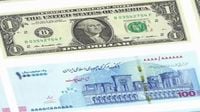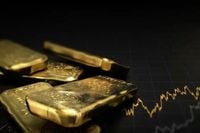On June 13, 2025, financial markets in Iran were rocked by a surge in the value of the dollar and gold prices, triggered by a sudden escalation in regional tensions following an Israeli military strike on Iranian soil. This attack resulted in the martyrdom of several senior Iranian commanders, sending shockwaves through the nation's economy and stirring uncertainty across currency and commodity markets.
According to reports from Banker and other financial news outlets, the Iranian rial's exchange rate against the dollar soared to 93,165 tomans in the free market—a historic high that underscores the fragility of the current economic climate. The euro also climbed significantly, trading at 107,520 tomans, while Tether, a popular cryptocurrency stablecoin, was valued at 91,333 tomans. Economic experts have expressed concern that if the regional conflict endures, the dollar could breach the 95,000 toman threshold in the days ahead, further exacerbating economic instability.
The gold market mirrored this volatility. Prices for 18-carat gold surged to 6,845,655 tomans per gram, and the price per mesghal—a traditional Iranian gold weight unit—reached 29,656,400 tomans. This spike reflects a common investor behavior in periods of political turmoil: a flight to safe-haven assets such as gold, which is often seen as a store of value amid uncertainty.
Market analysts attribute the sharp rise in gold and currency prices to the psychological impact of the military strike and the subsequent threats from Iran of reciprocal actions. The martyrdom of high-ranking commanders has intensified fears of prolonged regional conflict, which weighs heavily on investor confidence and fuels rapid price movements.
Adding further context, the U.S. Dollar Index (USDX), a global benchmark measuring the strength of the dollar against a basket of currencies, was also closely monitored on June 13. While the index provides a gauge of the dollar’s international standing, the domestic Iranian market’s response was particularly pronounced, reflecting the unique pressures from geopolitical developments.
Meanwhile, global gold prices presented a more complex picture. Reports from Eghtesad News indicated fluctuations in the price of gold ounces, with figures showing a decrease from 33,866 dollars to 3,437 dollars on June 13 at 17:25 local time. Although the numbers suggest a decline, the accompanying narrative described the price movement as an increase, highlighting potential discrepancies or local unit interpretations. Regardless, the overall trend in Iran was clearly upward for gold prices, driven by domestic demand and the flight to security amid unrest.
The backdrop to these financial tremors is the recent Israeli military operation inside Iranian territory, which resulted in the loss of several senior Iranian military leaders. This event has not only intensified political tensions but has also injected a significant degree of uncertainty into the markets. The immediate aftermath saw a sharp sell-off of the rial and a rush toward gold, traditionally perceived as a hedge against currency devaluation and geopolitical risk.
Experts warn that unless the political situation stabilizes swiftly, these volatile conditions may persist, potentially leading to record-breaking highs in both the dollar and gold markets. The psychological atmosphere in the market remains fragile, with investors wary of further escalations and their economic ramifications.
While the government and financial authorities have yet to announce specific measures to counteract the market upheaval, the current scenario underscores the deep interconnection between geopolitical events and economic stability in the region. The Iranian economy, already grappling with sanctions and inflationary pressures, faces new challenges as external conflicts ripple through currency and commodity valuations.
In summary, the events of June 13, 2025, marked a significant moment for Iran’s financial markets, illustrating how swiftly political violence can translate into economic turbulence. With the dollar hitting unprecedented levels and gold prices climbing sharply, investors and policymakers alike are bracing for what may come next in a region fraught with uncertainty.





